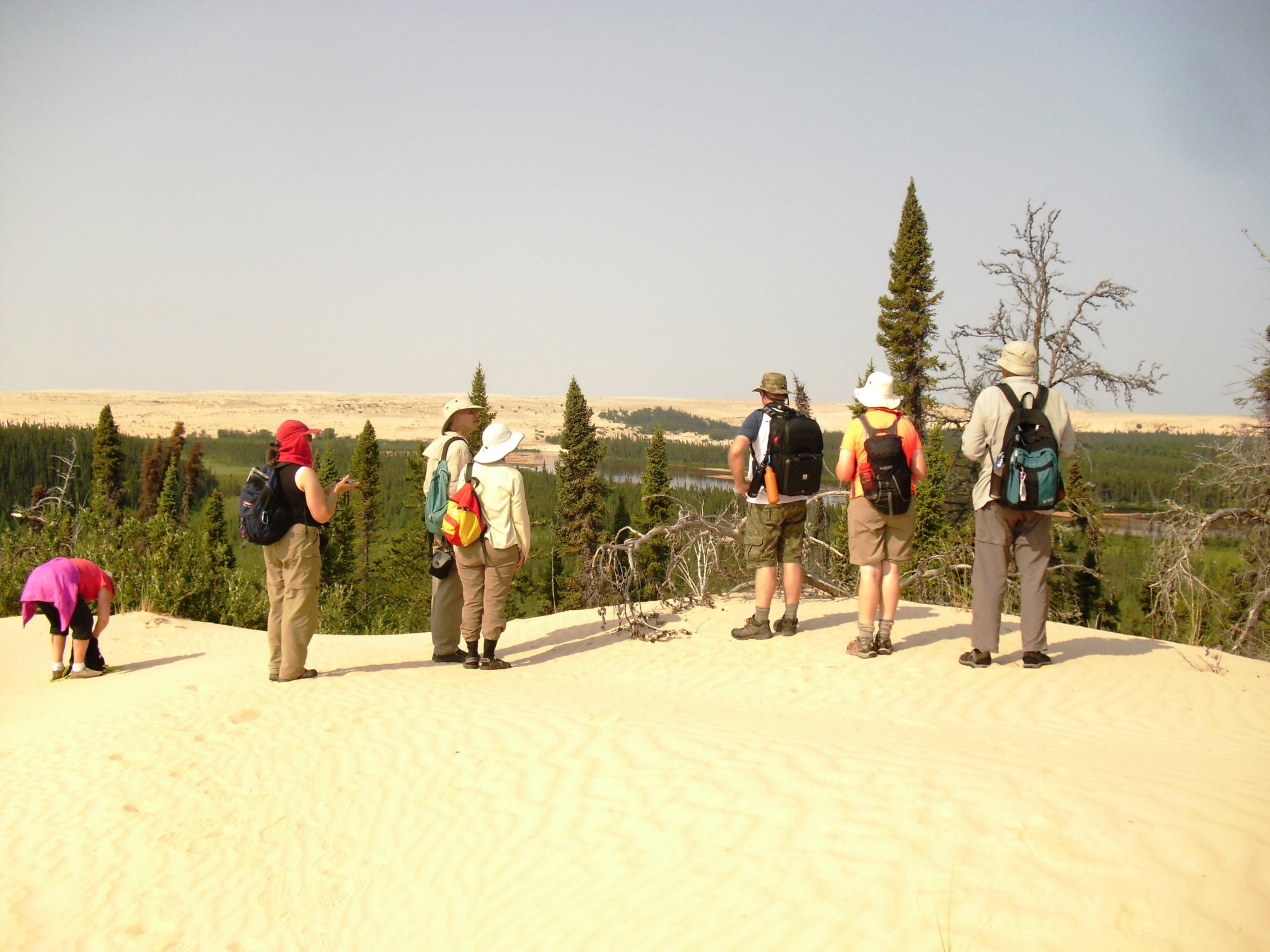Eco-Education travel with the Saskatoon Zoo Society
Tentative dates for 2017: July 2 to July 6
Trip information sessions: Everyone welcome
Sunday, March 26 at 1:00 p.m. in the Affinity Learning Centre at the Saskatoon Forestry Farm Park and Zoo.
Saturday, April 29 at 1:00 p.m. in the Affinity Learning Centre at the Saskatoon Forestry Farm Park and Zoo.
Join Greg Fenty from the Saskatoon Zoo Society for this wilderness educational adventure of a lifetime. The Athabasca Sand Dunes are a series of dune fields stretching for about 100 km along the south shore of Lake Athabasca. It is an ecologically fragile area, characterized by sand dunes, pebble covered surfaces, sand-blasted structures, many rare plant species and archaeological evidence of First Nations dating back over 7000 years. It is the world’s most northerly sand dune formation. Some dunes reach up to 30m high.
Travel:
We will fly from Saskatoon to Fond du Lac, then travel by boat to our campsite at Thomson Bay on Lake Athabasca. Our base camp is on the edge of 2,000 square kilometers of active sand dunes and northern forest.
Requirements:
You must be comfortable with wildness camping, preparing your own meals, and hiking from 10 to 26 km. If you are concerned about whether you are up to this challenge, consult with your doctor.
Fees and Details:
2016 Fee: $2750.00 +GST ($137.50)
2017 $3200.00 + GST (10% deposit due by May 1, 2017)
Group Minimum 7, people. Maximum 10 people.
Fee includes a return flight from Saskatoon to Fond du Lac and boat travel from Fond du Lac to Thomson Bay.
This is a wilderness camping tour at Thomson Bay on Lake Athabasca. We will pack our own food and equipment for a 5-day adventure.
Where you will go:
We fly from Saskatoon to Fond du Lac and then travel by boat to Lake Athabasca’s south shore in Thompson Bay. Here we will set up base camp on the edge of 2000 square kilometers of active sand interspersed with northern forests, small lakes and streams.
What you will do:
Each day we will hike into a different area of the dunes to explore and learn. Most hikes are 10 – 18 km long; the longest hike is around 26 km. We will observe wildlife, take photographs, visit dune fields, willow dunes, dune slacks, gobi flats, blowouts, and more. We will have breakfasts and suppers at camp, but lunches in the field.
You will learn:
We will have information sessions to prepare yourself for as much learning as possible.
On hikes we will learn about the sand dune landscape and sand dune evolution. We will also see and learn about local vegetation, fascinating plant species, such as Felt-leaved Willow and W0olly Tansy, that grown nowhere else on Earth. We will explore how plant and insect species survive in the extreme conditions of hot and blasting sand. We may see northern birds and other animals (and/or their signs).
How you qualify:
No particular qualifications are required, except that you need to be in good health and have a positive attitude about camping in remote wilderness for the duration of the program (even if the weather turns poor). If you are concerned about whether your health is up to the challenge, consult with your doctor.
How you prepare:
We will give you a list of minimum items to bring. Your list will include a tent, sleeping bag and pad, basic personal belongings, clothes, and food. Since there is a weight limit on what you may bring, we will discuss what kinds of food stuffs and gear to pack.
Although the trip is not physically demanding in normal circumstances, you may wish to strengthen your hiking muscles ahead of time.
How you register:
You may secure your spot by paying a deposit fee of 10% by May 1, 2017. (Remainder of payment due by June 1, 2017). This is advisable as the trip has a limit of 10 people (including your guide). To register call the Saskatoon Zoo Society at 306-975-3395. You can register by phone or in person at the Forestry Farm Administration Building (Monday-Friday 8:30 a.m. – 4:30 p.m.). The Zoo Society accepts cheques, cash, Visa and MasterCard.
Your Tour Leader:
Greg Fenty is a biologist and environmental educator. He is the recipient of the 2011 MVA Conservation Award and has been a Saskatoon Zoo Society educator since 1996. He has led trips to the Athabasca Sand Dunes Provincial Park and Churchill, Manitoba, for the University of Saskatchewan’s Continuing and Distance Education. Greg has lived in worked in northern environments for many years and is experienced in wildness camping. He is also trained in first aid and CPR.
For more information call 306-975-3395 or e-mail info@saskatoonzoosociety.ca


